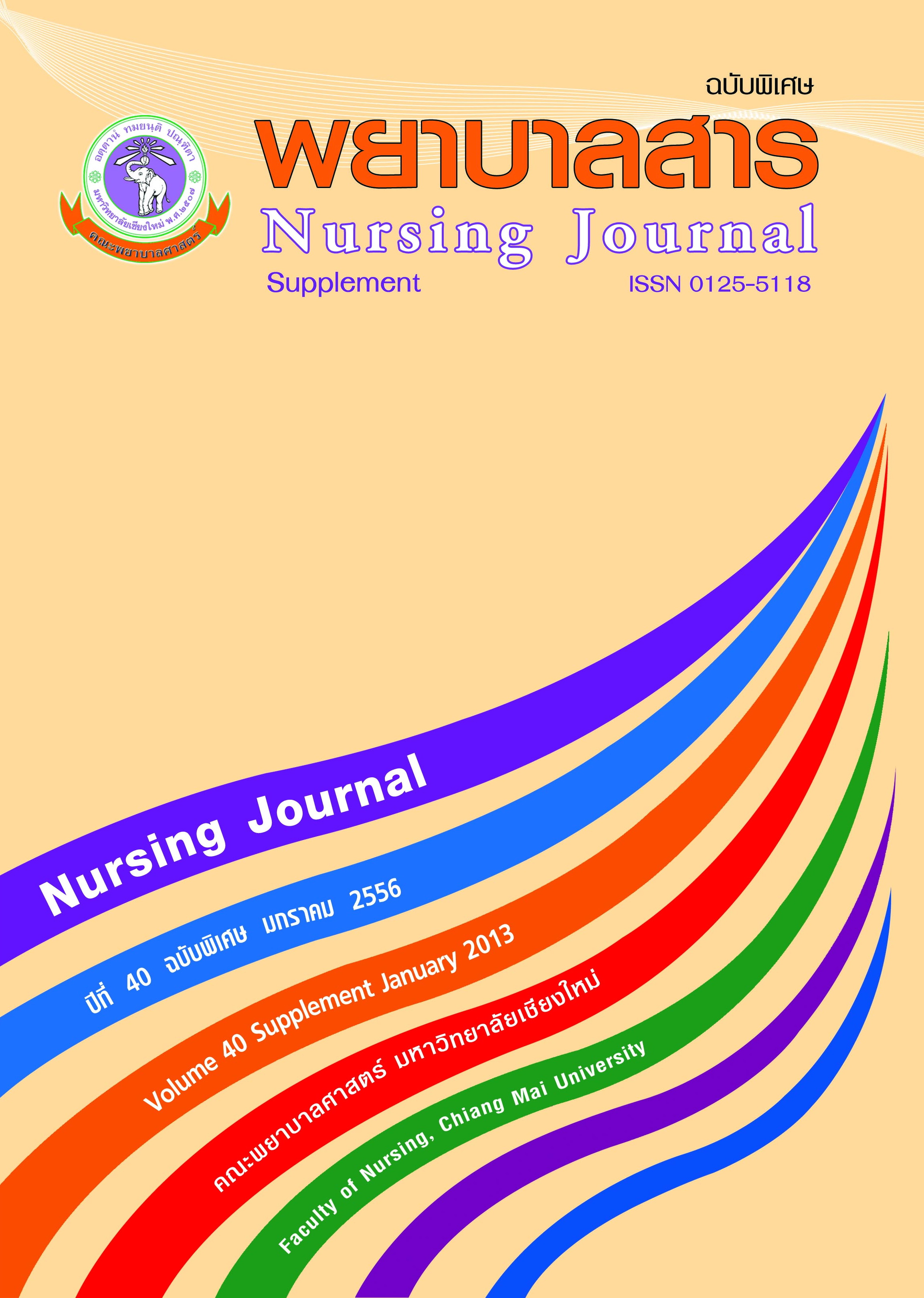ความต้องการและการได้รับการตอบสนองความต้องการของผู้ป่วยสูงอายุและครอบครัวในหอผู้ป่วยหนักศัลยกรรม รงพยาบาลมหาราชนครเชียงใหม่
Keywords:
ความต้องการ, การได้รับการตอบสนองความต้องการ, ผู้ป่วยสูงอายุ, สมาชิกในครอบครัวผู้ป่วยสูงอายุAbstract
บทคัดย่อ
ความต้องการและการได้รับการตอบสนองความต้องการของผู้ป่วยสูงอายุและครอบครัวใน หอผู้ป่วยหนักศัลยกรรมเป็นสิ่งสำคัญสำหรับพยาบาล ในการช่วยเหลือผู้ป่วยสูงอายุและครอบครัวให้ได้รับการตอบสนองได้ตรงตามความต้องการ เพื่อให้ผู้ป่วยสูงอายุได้รับการดูแลที่มีประสิทธิภาพสูงสุด วัตถุประสงค์ในการวิจัยเพื่อเปรียบเทียบความต้องการและการได้รับการตอบสนองความต้องการของผู้ป่วยสูงอายุที่เข้ารับการรักษาในหอผู้ป่วยหนักและครอบครัว กลุ่มตัวอย่างในการศึกษาประกอบด้วยผู้ป่วยสูงอายุจำนวน 30 ราย และสมาชิกในครอบครัวที่มีความสัมพันธ์โดยตรงกับผู้ป่วยจำนวน 30 ราย เลือกกลุ่มตัวอย่างแบบเฉพาะเจาะจงตามคุณสมบัติที่กำหนดเครื่องมือที่ใช้ในการรวบรวมข้อมูลประกอบด้วย 2 ส่วน ได้แก่ 1) เครื่องมือรวบรวมข้อมูลของผู้ป่วยสูงอายุประกอบด้วย แบบบันทึกข้อมูลส่วนบุคคล แบบสัมภาษณ์ความต้องการและการได้รับการตอบสนองความต้องการของผู้ป่วยสูงอายุ ที่ดัดแปลงจากแบบสัมภาษณ์การได้รับการตอบสนองความต้องการของผู้ป่วยของพรเพ็ญวงศ์คำแน่น (2551) ที่ประยุกต์ขึ้นจากแนวคิดของยูราและวอล์ช (Yura & Walsh, 1983) 2) เครื่องมือรวบรวมข้อมูลของสมาชิกในครอบครัวของผู้ป่วยสูงอายุ ประกอบด้วย แบบบันทึกข้อมูลส่วนบุคคล แบบสัมภาษณ์ความต้องการและการได้รับการตอบสนองความต้องการของสมาชิกในครอบครัวผู้ป่วยสูงอายุ ที่ประยุกต์ขึ้นจากแบบสำรวจความต้องการของครอบครัวผู้ป่วยวิกฤต (The Critical Care Family Needs Inventory: CCFNI) ตามแนวคิดของ มอลเตอร์(Molter, 1979) ตรวจสอบความตรงตามเนื้อหา (content validity) ได้ค่าดัชนีความตรงตามเนื้อหาเท่ากับ0.90 และ 0.95 ตามลำดับ และนำไปทดสอบความเชื่อมั่นของเครื่องมือ ได้ค่าสัมประสิทธิ์แอลฟาของครอนบาคเท่ากับ 0.89 และ 0.92 ตามลำดับ วิเคราะห์ข้อมูลโดยการหาค่าเฉลี่ย ส่วนเบี่ยงเบนมาตรฐาน และสถิติทดสอบค่าที (paired t-test)
ผลการวิจัย พบว่า
1. ผู้ป่วยสูงอายุมีความต้องการโดยรวมอยู่ในระดับมาก (x_=3.10, S.D.=0.35) โดยความต้องการสูงสุดได้แก่ ความต้องการการช่วยเหลือให้ได้รับสารนํ้าอย่างเพียงพอ (x_=3.67, S.D.=0.35) และความต้องการตํ่าสุดได้แก่ การช่วยเหลือในการดูดเสมหะ/ ขับเสมหะ/ การไอ (x_=1.54, S.D.=0.54)
การได้รับการตอบสนองความต้องการของผู้ป่วยสูงอายุโดยรวมอยู่ในระดับปานกลาง (x_=2.95,S.D.=0.53) โดยการได้รับการตอบสนองความต้องการสูงสุด ได้แก่ การช่วยเหลือให้แผลผ่าตัดแห้งสะอาด(x_=3.69, S.D.=0.40) และการได้รับการตอบสนองความต้องการตํ่าสุดได้แก่ การช่วยเหลือให้ได้อยู่ในสิ่งแวดล้อมที่เงียบ ไม่มีเสียงรบกวน (x_=2.15, S.D.=0.45)
การเปรียบเทียบความต้องการและการได้รับการตอบสนองความต้องการของผู้ป่วยสูงอายุ พบว่าคะแนนความต้องการ (mean = 73.68, S.D.= 4.89) สูงกว่าการได้รับการตอบสนองความต้องการ (mean = 71.58,S.D.=2.56) อย่างไม่มีนัยสำคัญทางสถิติ (t = -0.764, P = 0.525)
2. สมาชิกในครอบครัวของผู้ป่วยสูงอายุมีความต้องการโดยรวมอยู่ในระดับปานกลาง (x_=2.48,(S.D.=0.43) โดยความต้องการเป็นรายข้อสูงสุดได้แก่ การมีแพทย์/พยาบาลที่สามารถช่วยเหลือผู้ป่วยเท่ากับการได้รับการเอาใจใส่จากพยาบาล (x_=3.68, S.D.=0.37) และความต้องการตํ่าสุดได้แก่ การมีผู้ช่วยเหลือด้านการเงิน (x_=1.28, S.D.=0.42)
การได้รับการตอบสนองความต้องการในภาพรวมอยู่ในระดับปานกลาง (x_=2.46, S.D.=0.37) การตอบสนองความต้องการสูงสุดได้แก่ การได้รับการเอาใจใส่จากพยาบาล (x_=3.84, S.D.=0.31) และการได้รับการตอบสนองความต้องการที่ตํ่าสุดได้แก่ การได้ระบายความรู้สึกของตนเองกับใครสักคน (x_=1.44, S.D.=0.36)
การเปรียบเทียบระดับความต้องการและการได้รับการตอบสนองความต้องการของสมาชิกในครอบครัวผู้ป่วยสูงอายุ พบว่า คะแนนความต้องการ (mean = 64.88, S.D.= 3.26) สูงกว่าการได้รับการตอบสนองความต้องการ (mean = 63.77, S.D.=2.51) อย่างไม่มีนัยสำคัญทางสถิติ (t = -0.66, p = 0.848)
คำสำคัญ: ความต้องการ การได้รับการตอบสนองความต้องการ ผู้ป่วยสูงอายุ สมาชิกในครอบครัวผู้ป่วยสูงอายุ
Abstract
Needs and received need responses of elderly patients and family in surgical intensivecare unit are essential for nurses to help elderly patients and their families to meet the needsleading to the most effective care for them. The purpose of this study was to compare the needsand received need responses of elderly patients and their families admitted to the intensive care unit. The study sample, using purposive sampling, consisted of 30 elderly patients and 30 familymembers who are directly related to the patients. The questionnaire used for data collectionconsisted of two parts: 1) the questionnaire for the elderly patients included:- demographic data,needs and received need responses of the elderly patients which was adapted from received needresponses of patients questionnaire developed by Pornpen Wongkumnan (2551) applied from theconcept of Yura & Walsh (1983) 2) the questionnaire for the family members of elderly patientsincluded:- demographic data , needs and received need responses of the family members ofelderly patients which adapted from The Critical Care Family Needs Inventory (CCFNI) based onthe concept of Molter (1979). The reliability of the questionnaires, using Cronbach's coefficient, was0.89 and 0.92. Consecutively data were analysed using mean, standard deviation and paired t-test.
The results of study
1. Overall needs of the elderly patients were at a high level (x_= 3.10, S.D. = 0.35). Thehighest need was the need for assistance to get enough fluids (x_= 3.67, S.D. = 0.35). The lowestone was the need for helping suction (x_= 1.54, SD = 0.54).
Overall received need responses of elderly patients were at a moderate level (x_= 2.95,S.D. = 0.53). The highest received need responses was the assistance for keeping the surgicalwound clean and dry (x_= 3.69, S.D. = 0.40).The lowest one was the assistance for providingquiet environment (x_= 2.15, S.D. = 0.45).
For a comparison of needs and received need responses of the elderly patients (mean =71.58, S.D. = 2.56), it was found that the score of needs (mean = 73.68, S.D. = 4.89) has nosignificantly higher than that of received need responses (mean = 71.58, S.D. = 2.56).
2. Overall needs of the elderly family members were at a moderate level (x_= 2.48,(S.D. = 0.43). The highest need was from 2 items with the same score including the abilityof doctor/nurse to help the patient and receiving care from a nurse (x_= 3.68, S.D. = 0.37).The lowest one was the financial assistance (x_= 1.28, S.D. = 0.42).
Overall received need responses were at a moderate level (x_= 2.46, S.D. = 0.37). Thehighest received need response was receiving care from a nurse (x_= 3.84, S.D. = 0.31). Thelowest one was share their though to someone (x_= 1.44, S.D. = 0.36).
For a comparison of needs and received need responses among family members of theelderlypatients, it was found that the score of needs (mean = 64.88, SD = 3.26) has no significantlyhigher than that of received need responses (mean = 63.77, S.D. = 2.51).
Key words: Needs, Received Need Responses, Elderly Patients, Family Membersof Elderly Patients
Downloads
How to Cite
Issue
Section
License
บทความที่ได้รับการตีพิมพ์เป็นลิขสิทธิ์ของวารสารพยาบาลสาร
ข้อความที่ปรากฏในบทความแต่ละเรื่องในวารสารวิชาการเล่มนี้เป็นความคิดเห็นส่วนตัวของผู้เขียนแต่ละท่านไม่เกี่ยวข้องกับมหาวิทยาลัยเชียงใหม่ และคณาจารย์ท่านอื่นๆในมหาวิทยาลัยฯ แต่อย่างใด ความรับผิดชอบองค์ประกอบทั้งหมดของบทความแต่ละเรื่องเป็นของผู้เขียนแต่ละท่าน หากมีความผิดพลาดใด ๆ ผู้เขียนแต่ละท่านจะรับผิดชอบบทความของตนเองแต่ผู้เดียว






